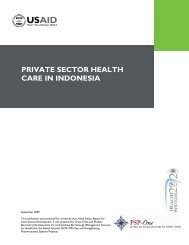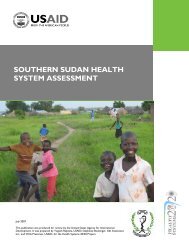An assessment of interactions between global ... - ResearchGate
An assessment of interactions between global ... - ResearchGate
An assessment of interactions between global ... - ResearchGate
Create successful ePaper yourself
Turn your PDF publications into a flip-book with our unique Google optimized e-Paper software.
Health Policy<br />
Siegfried Modola/IRIN<br />
proposals to GAVI and the Global Fund (table 4). The<br />
health systems component <strong>of</strong> GAVI includes<br />
requirements for sectoral oversight and coordination,<br />
and for the management <strong>of</strong> the application process<br />
through the ministry <strong>of</strong> health’s planning department.<br />
In an analysis <strong>of</strong> proposals by Galichet and colleagues<br />
(study 1, table 2), 73% <strong>of</strong> 48 applications that were<br />
reviewed included a national health plan for the period<br />
<strong>of</strong> proposed funding, or its equivalent. Two countries<br />
used the proposal process to finalise work on their<br />
national health plans, and as a stimulus for planning at<br />
low levels. The nine applications that were submitted<br />
without any planning or strategic documentation were<br />
referred for resubmission. The degree <strong>of</strong> alignment<br />
with planning processes in a country was good. 68% <strong>of</strong><br />
disbursements by the Global Fund in 2007 were for<br />
programme-based approaches, whereas in 62% <strong>of</strong><br />
countries Global Fund-supported grants were aligned<br />
with country cycles (study 11, table 2).<br />
However, the country proposals show an uneven<br />
demand for the operational aspects <strong>of</strong> direct provision <strong>of</strong><br />
services rather than for addressing some <strong>of</strong> the systemic<br />
constraints related to sustainable health service provision.<br />
For example, <strong>of</strong> the $450 million requested for health<br />
services from the Global Fund, $118 million was for the<br />
support <strong>of</strong> direct provision <strong>of</strong> services (treatment,<br />
prevention, and care; study 11, table 2). By contrast,<br />
funding requested for technical capacity building for<br />
service provision amounted to only $50 million (study 11,<br />
table 2). Whether the nature <strong>of</strong> the demand for health<br />
systems is determined by a country capacity that is<br />
inadequate for identifying and addressing the long-term<br />
systemic needs, or whether it is also determined by real<br />
or perceived constraints about what activities are likely to<br />
be approved through the health systems strengthening<br />
component <strong>of</strong> GHI funding is not clear and merits<br />
further attention.<br />
Community involvement<br />
GHIs have improved community participation in the<br />
governance <strong>of</strong> public health. Non-governmental organisations,<br />
faith-based organisations, and other civil<br />
society organisations are directly funded by GHIs and<br />
participate in the planning and provision <strong>of</strong> health<br />
activities targeted by these initiatives. 14,108,122,123 Nearly<br />
20% <strong>of</strong> the grant money from the Global Fund for the<br />
seventh round <strong>of</strong> funding was channelled through nongovernmental<br />
organisations, 124 and non-state organisations<br />
account for 50% <strong>of</strong> principal recipients or<br />
subrecipients. 125 Non-governmental organisations and<br />
other community-based organisations play a large<br />
implementation part for PEPFAR. In 2005, more than<br />
40% <strong>of</strong> funding for prime partners and almost 70% <strong>of</strong><br />
funding for subpartners was granted to non-governmental<br />
or faith-based organisations. 126 Non-state,<br />
not-for - pr<strong>of</strong>it organisations have been effective<br />
recipients <strong>of</strong> GHI funds and have done better than<br />
government recipients. 126–130<br />
The contribution <strong>of</strong> GHIs to building capacity outside<br />
the state sector has promoted the decentralisation <strong>of</strong><br />
health management but has also raised issues about<br />
subnational coordination. For example, in several African<br />
countries the rapid growth <strong>of</strong> the non-governmentalorganisation<br />
sector when many <strong>of</strong> these organisations<br />
had little capacity and were weakly accountable has<br />
caused concern. 109,119,131 Generally, community engagement<br />
2152 www.thelancet.com Vol 373 June 20, 2009
















